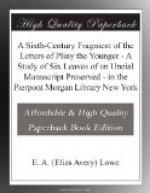In a later article Professor Merrill well adds that even the uncial script would have seemed difficult and alien to one accustomed to the current fifteenth-century style.[4] A contemporary and rival editor, Catanaeus, disputed Aldus’s claims. In his second edition of the Letters (1518), he professed to have used a very ancient book that came down from Germany and declared that the Paris manuscript had no right to the antiquity which Aldus had imputed to it. But Catanaeus has been proved a liar.[5] He had no ancient manuscript from Germany, and abused Aldus mainly to conceal his cribbings from that scholar’s edition; we may discount his opinion of the age of the Parisinus. Until Aldus, an eminent scholar and honest publisher,[6] is proved guilty, we should assume him innocent of mendacity or naive ignorance. He speaks in earnest; his words ring true. We must be prepared for the possibility that his ancient manuscript was really ancient.
[Footnote 4: C.P. X (1915), pp. 18 f.]
[Footnote 5: By Merrill, C.P. V (1910), pp. 455 ff.]
[Footnote 6: Sandys, A History
of Classical Studies II (1908),
pp. 99 ff.]
Since Aldus’s time the Parisinus has disappeared. To quote Merrill again:[7]
“This wonderful manuscript, like so many others, appears to have vanished from earth. Early editors saw no especial reason for preserving what was to them but copy for their own better printed texts. Possibly some leaves of it may be lying hid in old bindings; possibly they went to cover preserve-jars, or tennis-racquets; possibly into some final dust-heap. At any rate the manuscript is gone; the copy by Iucundus is gone; the copy of the correspondence with Trajan that Avantius owed to Petrus Leander is gone; if others had any other copies of Book X, in whole or in part, they are gone too.”
[Footnote 7: C.P. II, p. 135.]
[Sidenote: The Bodleian volume]
In 1708 Thomas Hearne, the antiquary, bought at auction a peculiar volume of Pliny’s Letters. It consisted of Beroaldus’s edition of the nine books (1498), the portions of Book X published by Avantius in 1502, and, on inserted leaves, the missing letters of Books VIII and X.[8] The printed portions, moreover, were provided with over five hundred variant readings and lemmata in a different hand from that which appeared on the inserted leaves; the hand that added the variants also wrote in the margin the sixteenth letter of Book IX, which is not in the edition of Beroaldus. Hearne recognized the importance of this supplementary matter, for he copied the variants into his own edition of the Letters (1703), intending, apparently, to use them in a larger edition which he is said to have published in 1709; he also lent the book to Jean Masson, who refers to it in his Plinii Vita. Upon Hearne’s death, this valuable volume was acquired by the Bodleian Library in Oxford, but lay unnoticed until Mr. E.G. Hardy, in 1888,[9] examined it and, after a comparison of the readings, pronounced it the very copy from which Aldus had printed his edition in 1508. External proof of this highly exciting surmise seemed to appear in a manuscript note on the last page of the edition of Avantius, written in the hand that had inserted the variants and supplements throughout the volume:[10]




